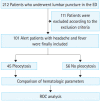Hematologic parameters to predict negative cerebrospinal fluid examination results among neurologically intact patients who underwent lumbar puncture on suspicion of central nervous system infection
- PMID: 28435899
- PMCID: PMC5385510
- DOI: 10.15441/ceem.16.152
Hematologic parameters to predict negative cerebrospinal fluid examination results among neurologically intact patients who underwent lumbar puncture on suspicion of central nervous system infection
Abstract
Objective: Cerebrospinal fluid (CSF) examination is mandatory whenever central nervous system (CNS) infection is suspected. However, pleocytosis is not detected in a substantial number of suspected patients who undergo CSF examination. This study aimed to identify parameters that can aid in predicting negative CSF examination results (defined as a white blood cell count of <5 cells/high-power field).
Methods: The study included 101 neurologically intact patients who underwent lumbar puncture because of suspicion of CNS infection. Patients were divided into negative and positive CSF examination groups, and their initial blood tests were comparatively analyzed.
Results: The negative group had a significantly higher proportion of neutrophils in white blood cells (81.5% vs. 75.8%, P=0.012), lower proportion of lymphocytes in white blood cells (9.3% vs. 16.7%, P=0.001), a higher neutrophil-to-lymphocyte ratio (9.1 vs. 4.4, P=0.001), a lower lymphocyte-to-monocyte ratio (1.6 vs. 2.4, P=0.008), and a higher C-reactive protein level (21.0 vs. 5.0 mg/L, P<0.001) than the positive group. In the receiver-operating characteristic analysis, neutrophil-to-lymphocyte ratio and C-reactive protein had an area under the curve of >0.7, and the best cutoff values were 6.0 (accuracy 70.3%) and 12.7 mg/L (accuracy 76.2%), respectively.
Conclusion: The neutrophil-to-lymphocyte ratio ≥6 and C-reactive protein level ≥12.7 mg/L was significantly associated with negative CSF examination result.
Keywords: C-reactive protein; Central nervous system infection; Neutrophil-to-lymphocyte ratio; Neutrophils.
Conflict of interest statement
No potential conflict of interest relevant to this article was reported.
Figures
Similar articles
-
Low blood CD8+ T-lymphocytes and high circulating monocytes are predictors of HIV-1-associated progressive encephalopathy in children.Pediatrics. 2003 Feb;111(2):E168-75. doi: 10.1542/peds.111.2.e168. Pediatrics. 2003. PMID: 12563091
-
C-reactive protein and immature-to-total neutrophil ratio have no utility in guiding lumbar puncture in suspected neonatal sepsis.J Paediatr Child Health. 2018 Aug;54(8):848-854. doi: 10.1111/jpc.13890. Epub 2018 Mar 30. J Paediatr Child Health. 2018. PMID: 29602260
-
The relationship between hematological parameters and prognosis of children with acute ischemic stroke.Childs Nerv Syst. 2018 Apr;34(4):655-661. doi: 10.1007/s00381-017-3673-x. Epub 2017 Dec 5. Childs Nerv Syst. 2018. PMID: 29209887
-
A systematic review of cases of meningitis in the absence of cerebrospinal fluid pleocytosis on lumbar puncture.BMC Infect Dis. 2019 Aug 5;19(1):692. doi: 10.1186/s12879-019-4204-z. BMC Infect Dis. 2019. PMID: 31382892 Free PMC article.
-
Cerebrospinal fluid leucocyte counts in healthy neonates.Arch Dis Child Fetal Neonatal Ed. 2006 Sep;91(5):F357-8. doi: 10.1136/adc.2005.082826. Epub 2006 Jan 17. Arch Dis Child Fetal Neonatal Ed. 2006. PMID: 16418305 Free PMC article. Review.
Cited by
-
Neutrophil-to-lymphocyte ratio as a feasible prognostic marker for pyogenic liver abscess in the emergency department.Eur J Trauma Emerg Surg. 2019 Apr;45(2):343-351. doi: 10.1007/s00068-018-0925-8. Epub 2018 Feb 26. Eur J Trauma Emerg Surg. 2019. PMID: 29480320
References
-
- van de Beek D, de Gans J, Spanjaard L, Weisfelt M, Reitsma JB, Vermeulen M. Clinical features and prognostic factors in adults with bacterial meningitis. N Engl J Med. 2004;351:1849–59. - PubMed
-
- Williams J, Lye DC, Umapathi T. Diagnostic lumbar puncture: minimizing complications. Intern Med J. 2008;38:587–91. - PubMed
-
- Bonadio WA. The cerebrospinal fluid: physiologic aspects and alterations associated with bacterial meningitis. Pediatr Infect Dis J. 1992;11:423–31. - PubMed
-
- Axelrod YK, Diringer MN. Temperature management in acute neurologic disorders. Neurol Clin. 2008;26:585–603. - PubMed
-
- World Medical Association Declaration of Helsinki Recommendations guiding physicians in biomedical research involving human subjects. Cardiovasc Res. 1997;35:2–3. - PubMed
LinkOut - more resources
Full Text Sources
Other Literature Sources
Medical
Research Materials


